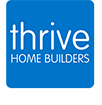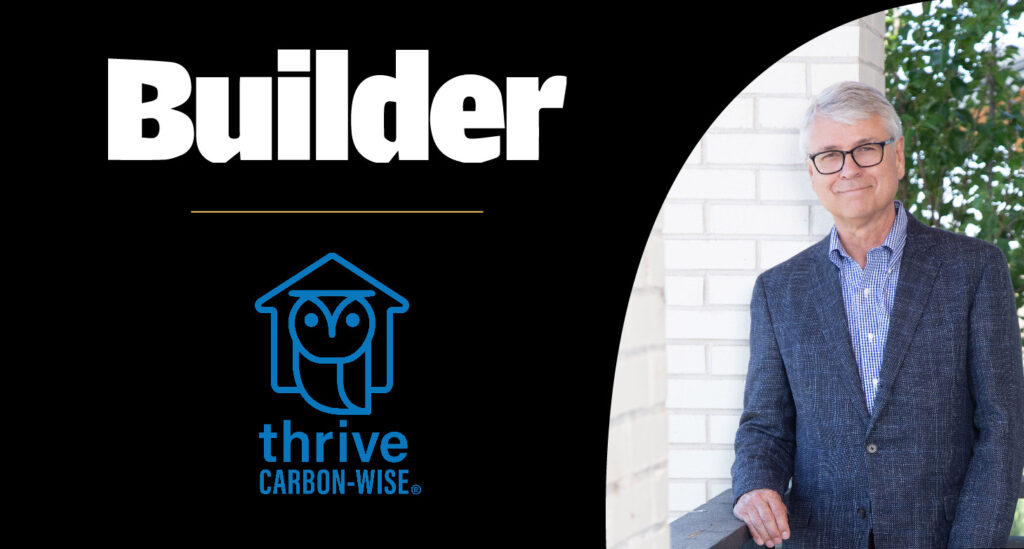BUILDER MAGAZINE ONLINE, Symone Strong | October 18, 2022
Earlier this year, Denver-based Thrive Home Builders introduced a new building approach to produce carbon-neutral homes. The construction method—called Thrive Carbon-Wise—focuses on reducing the embodied and operational carbon of a home and delivering a product that lessens the harsh impacts of carbon on the environment.
The builder will construct homes for the first time with this building approach in a community named Sonders in Fort Collins, Colorado, with two collections of single-level homes and one collection of townhomes. Production is targeted to begin this fall.
To learn more about carbon reduction methods and how the company plans to implement this new approach, BUILDER spoke with Gene Myers, chairman and chief sustainability officer at Thrive. In his responses, he explains the benefits of a carbon-neutral home, which products and processes need to be swapped to reduce a home’s carbon output, the challenges, and some recent trends from his travels overseas.
BUILDER: What exactly is Thrive Carbon-Wise?
Myers: Thrive Carbon-Wise is Thrive’s innovative and trademarked building approach focused on delivering carbon-neutral homes. This pioneering construction method focuses on reducing the embodied and operational carbon of homes Thrive builds. The result is delivering a home that lessens the harsh impacts of carbon on the environment and helps combat climate change.
BUILDER: How will it benefit homeowners? The community?
Myers: A carbon-neutral home means a healthier home for the homeowner and the environment. We’ve been witnessing the results of climate change locally and globally. Warmer temperatures due to climate change means a longer plant-growing season that contributes toward heightened pollen in the air that worsens allergies and asthma, and our healthy homes help with these airborne triggers.
Additionally, climate change as we know it today has rapidly impacted our environment and contributed toward massive wildfires, fires in our metro areas, and our ever-growing poor air quality. Carbon-neutral homes will help decrease the impacts of climate change one home buyer and home at a time.
BUILDER: What is the difference between embodied and operational carbon, as it relates to a home and a home’s construction?
Myers: Operational carbon consists of ongoing emissions from operating the home. Think utilities. If a home is all-electric with no fossil fuels in the home, the operational carbon would be reduced by the renewable energy portion of electricity available from the grid. If the home is net-zero energy, or producing its own energy through its rooftop solar array, and all-electric, the operational carbon emissions would be zero. Operational carbon repeats itself each year that the home is in operation.
Embodied carbon is the total carbon emissions produced during the manufacture and installation of all the parts and pieces of a home. This is a one-time impact.
BUILDER: What building processes/materials need to be altered to decrease a home’s carbon output?
Myers: To affect operational carbon, builders need to go all-electric and eliminate the burning of fossil fuels to operate the home. To the extent that fossil fuels remain a part of the electricity grid, builders can add solar panels to offset the fossil fuel component.
For embodied carbon, the worst offenders are concrete and building panels like OSB. While West Fraser in the U.K. has developed a carbon-negative OSB and particle board, most OSB in the U.S. is a major contributor to the embodied carbon of a new home. The U.S. Department of Energy (DOE) granted millions of dollars to national laboratories and universities to aid in the development of carbon-negative wood products. We are testing a fiberglass foundation system that has the promise of drastically reducing our use of concrete.
BUILDER: What has Thrive swapped out or changed to create a carbon-neutral home?
Myers: Thrive has already committed to all-electric homes in some of its projects. By the end of 2023, Thrive’s goal is to be an all-electric builder. Combined with the use of solar panels, our net-zero-energy homes will become operationally carbon neutral. To accommodate this, the big changes in our homes include air source heat pumps for heating and cooling as well as heat pump hot water heaters.
BUILDER: How does carbon reduction go hand in hand with energy efficiency?
Myers: It is much easier and less expensive to swap out typical fossil fuel appliances, such as hot water heaters and furnaces, if they are small in the first place. We accomplish this by building a very efficient building envelope. We have been doing this for many years in our pursuit of energy efficiency. Thus, all of the building science we have employed as an energy-efficient builder complements our goal of achieving carbon neutrality.
BUILDER: As one of the first production builders to implement something like carbon neutrality, what have been some of the challenges?
Myers: Years ago, when we were learning how to become an energy-efficient and healthy home builder, there were pioneers before us that showed the way. We connected with like-minded builders through the Energy and Environmental Building Alliance.
We also accessed training resources available through federal programs for efficiency like Energy Star and DOE Zero Energy Ready Home. Those programs gave us technical and marketing support that ensured that as we innovated, we avoided costly and damaging unintended consequences. Unfortunately, we have not found similar support for reaching carbon neutrality, although there are several promising groups working on the problem.
BUILDER: How did Thrive overcome those challenges?
Myers: We have found important allies such as Digibilt and MiTek to assist us in developing building information modeling design to get to a detailed bill of materials for our homes. With this, we can reference embodied carbon databases like the EC3 database that give us the resulting footprint of our homes. We have partnered with the University of Denver to evaluate the several embodied carbon databases to determine which is the most appropriate and accurate for use by a home builder like Thrive. Our next step is to work with manufacturers to increase the availability of Environmental Product Declarations that can be entered into the databases to improve the accuracy of our calculations.
BUILDER: How have potential buyers responded to purchasing a carbon-neutral home? Are they interested, or is there a learning curve with your sales managers?
Myers: While final pricing of these carbon-neutral homes is on the horizon, we think buyers will respond well to a healthy home and environment message. In fact, the city of Fort Collins, where we are building carbon-neutral homes, has already had a focus on carbon-neutral messaging. The city aims to build a healthy and sustainable community by 2050, with goals to reduce carbon by 80% in 2030 and be fully carbon neutral by 2050. I am proud to share that Thrive’s home building efforts will help contribute toward Fort Collins’ goals.
As this is a new shift in our building approach, naturally there will be a learning curve for our community sales managers. Thrive has sales managers train via one-on-one training sessions with Thrive’s chief operating officer and me for sustainability purposes. They also take training classes provided by manufacturers and sponsors.
BUILDER: After the 220 homes at Sonders are built, will all Thrive homes eventually be built with the Thrive Carbon-Wise building approach?
Myers: Our goal is that by the end of 2023, all Thrive homes will be carbon neutral.
BUILDER: Please share about your recent travels to the U.K. and what current green building trends you witnessed. Do they have any promising building practices that U.S. builders might want to incorporate?
Myers: It was surprising to learn that the builders we met in the U.K. and Sweden are still just beginning to consider how they will pursue carbon reduction. Their governments, however, are much more advanced. As I understand it, the U.K. will require about a 30% carbon reduction in 2026. In Sweden, a builder must calculate the carbon footprint of a home prior to obtaining a building permit. However, Sweden has yet to impose mandates for reduction upon builders. Sweden is seeking to benchmark the footprint of homes now so that future policy will have a realistic basis for future reduction.
In both countries, the historic building method was brick and block construction. Carbon reduction and energy-efficiency improvements are driving these countries toward the use of more wood for residential building. Since the precedent has been masonry, there is no “stick building” capacity to build with wood in the field as we do in the U.S. Therefore, most wood residential buildings are built using factory components or modules. While this has the potential to reduce waste and achieve high quality, cost remains a barrier, just as in the U.S.
SYMONE STRONG
Symone is an associate editor for Zonda’s BUILDER and Multifamily Executive magazines. She also has stories in other company publications, including ARCHITECT. She earned her B.S. in journalism and a minor in business communications from Towson University.


